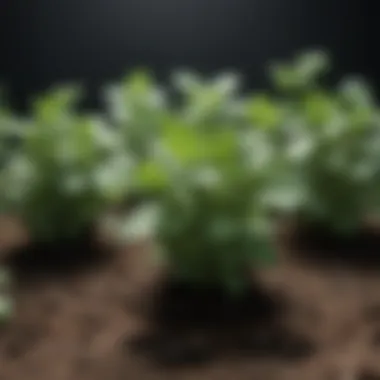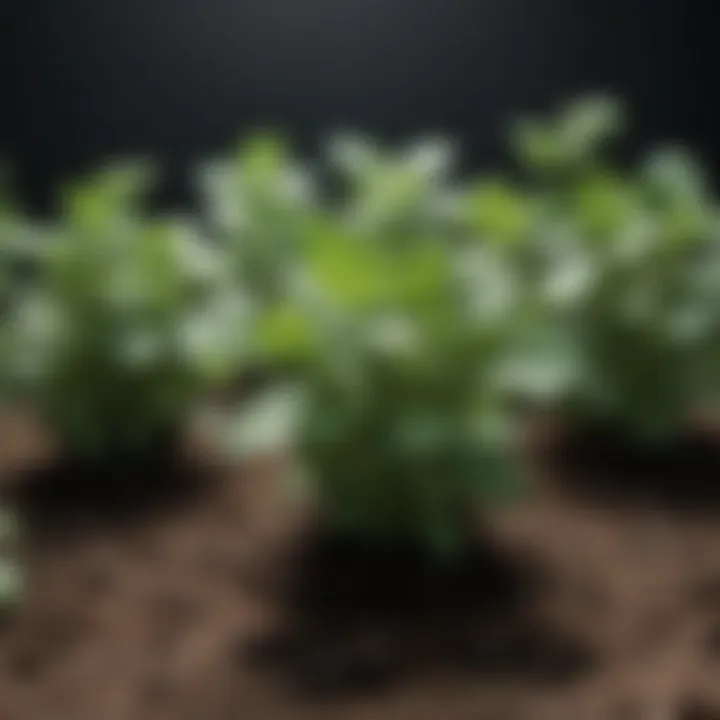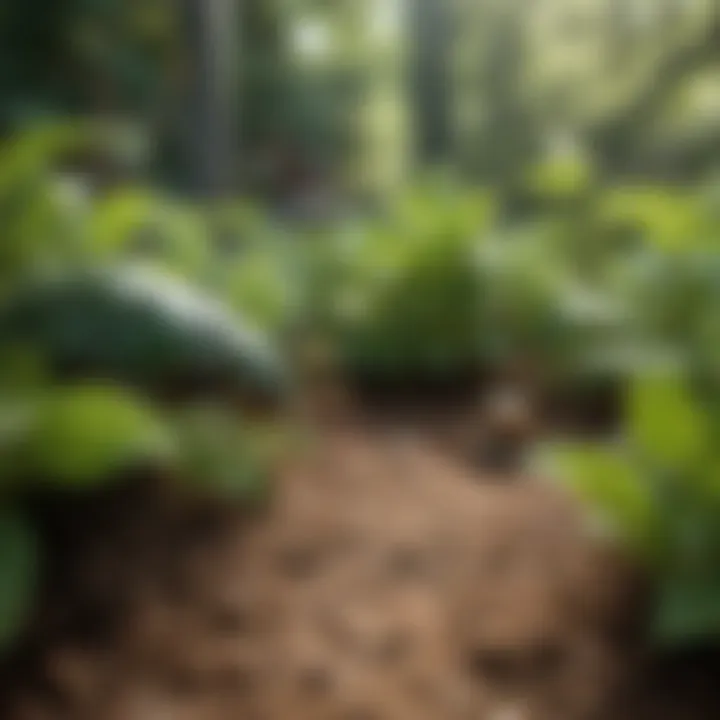A Comprehensive Guide to Planting Mint in Your Garden


Intro
Mint, known for its distinct aroma and versatile uses, has become a favorite among gardeners. This aromatic herb is not only delightful in culinary applications but also offers several health benefits. Growing mint in your garden can enhance your landscape while providing a fresh supply for teas, garnishes, and even medicinal uses. However, understanding how to plant and care for mint effectively is crucial for maximizing its potential.
In this comprehensive guide, we will cover aspects of planting mint, including essential growth requirements, techniques for cultivation, and tips for pest management. Whether you are an expert gardener or a novice enthusiast, this article will equip you with the knowledge needed to successfully incorporate mint into your garden environment.
Prelude to Mint Cultivation
Mint is a popular herb that is widely appreciated for its aromatic qualities and culinary versatility. Understanding the fundamentals of mint cultivation is crucial for anyone interested in growing this herb in their garden. This section provides insights into the different varieties of mint, the notable advantages of growing it, and some key considerations that can influence its cultivation.
Understanding Mint Varieties
Mint is not a single entity; it encompasses a variety of types, each with its unique flavor and characteristics. The most common varieties include Peppermint, Spearmint, Chocolate Mint, and Apple Mint.
- Peppermint is known for its strong flavor and oil content. It is often used in teas and desserts.
- Spearmint has a milder taste and is frequently found in savory dishes and drinks like mojitos.
- Chocolate Mint offers an intriguing taste profile, combining mint with a hint of chocolate, making it ideal for desserts.
- Apple Mint is characterized by a fruity aroma, suitable for salads and jellies.
Choosing the right variety depends on personal preference and intended use. Each variety has distinct growing conditions, so knowing your choice can lead to successful cultivation. It is also essential to consider the growth habits of these varieties. For example, mint tends to spread rapidly, which can be beneficial if you want a lush patch but may require containment strategies to prevent it from overtaking other plants.
Benefits of Growing Mint
Growing mint in your garden offers numerous benefits that extend beyond its delightful aroma and taste. Here are some key advantages:
- Culinary Uses: Mint is versatile in the kitchen. It can elevate both sweet and savory dishes, enhancing flavors and experiences.
- Medicinal Properties: Mint has been used in traditional medicine for its soothing properties, particularly for digestive issues.
- Attracting Pollinators: Growing mint can attract beneficial insects like bees, which help pollinate other plants in the garden.
- Pest Deterrent: The strong scent of mint can deter certain pests, making it not only a culinary herb but also a companion plant in the garden.
Furthermore, mint is relatively easy to grow. It is resilient and adapts well to different environments, making it an excellent option for novice gardeners. Understanding these benefits will motivate you to include mint as a staple in your garden, ensuring both beauty and utility.
Choosing the Right Location
Selecting the right location for planting mint is crucial to ensure its healthy growth. Mint is notorious for spreading rapidly, and it can thrive in diverse conditions, but there are specific elements that can optimize its growth. This section will explore the factors you need to consider for a successful mint garden.
Sunlight Requirements
Mint generally prefers full sun to partial shade. Ideally, it should receive at least six hours of sunlight a day. However, too much direct sunlight, especially in hotter regions, can lead to wilting. The leaves may start to scorch if exposed to extreme heat.
A situation where mint can benefit from dappled sunlight is often ideal. Growing mint near taller plants that offer afternoon shade can keep the mint healthier while still providing necessary light. Understanding your unique climate conditions will help determine the best position.
- Growing Tips:
- Observe how sunlight moves through your garden over the course of the day.
- Identify areas of your garden that remain shady during peak sunlight hours.
- If you have limited sunlight, consider using reflective surfaces to maximize light exposure.
Soil Conditions for Mint
Mint thrives best in rich, well-draining soil. pH levels around 6.0 to 7.0 are ideal. Soil that retains moisture without becoming waterlogged is key, as mint prefers consistently moist conditions. Compacted or overly dry soil can impede growth.
Before planting, conducting a soil test is advised. This can reveal nutrient deficiencies or pH imbalances. You can amend the soil with organic matter, such as compost, to improve its texture. Here are necessary considerations for soil conditions:
- Organic Matter:
- Drainage:
- Incorporate well-rotted manure or leaf mold to enhance soil fertility.
- A good composition aids in moisture retention and nutrient supply.
- Ensure that the area has proper drainage to prevent root rot.
- Raised beds can be an effective solution in poorly draining conditions.
The key to a thriving mint plant is to create an environment where roots can easily spread and absorb nutrients while being protected from excess water.
By understanding these factors, you can choose the right location in your garden that caters to mint's needs, setting the stage for a lush and aromatic harvest.


Preparing for Planting
Preparing to plant mint is a critical step in ensuring that the plants thrive and can flourish in your garden. The effort you invest in this stage sets the groundwork for future growth. One must consider several essential elements, including soil quality and plant selection. Each aspect contributes to the health of the mint and its ability to thrive in its chosen environment.
Soil Testing and Amendment
Before planting, soil testing is essential. You need to understand what your soil contains. This knowledge will direct you on necessary amendments. A simple soil test can reveal pH levels and nutrient content. Mint prefers a slightly acidic to neutral soil, around 6.0 to 7.0 pH.
When you receive the results, check for deficiencies. If nutrient levels are low, consider enriching the soil with compost or organic matter. Adding aged manure or well-composted materials can enhance soil fertility. This amendment boosts the nutrients available to the mint.
Important: Always perform a soil test before planting. It saves time and effort later by ensuring proper conditions from the start.
Selecting Healthy Plants
The health of the plants you choose is vital. Look for mint that is vibrant and robust. Healthy plants not only grow better but also have better disease resistance. When selecting, avoid stunted or yellowing plants.
Choosing a mix of different mint varieties can also be beneficial, as it offers unique flavors for culinary use. Consider types like spearmint or peppermint, each bringing a distinct taste. When buying, inspect roots carefully. They should be thick and white, showing they are well established.
In summary, preparing adequately by testing your soil and selecting healthy plants will create a solid foundation for mint growth. This approach maximizes the benefits of growing mint in your garden.
Planting Mint
Planting mint is a crucial aspect of cultivating this versatile herb in your garden. Mint has a reputation for being both fragrant and useful, with applications in culinary, medicinal, and even aesthetic realms. When planting mint, it is essential to focus on several specific elements to achieve optimal growth.
Firstly, good planting techniques play a significant role in the health of the plant. Poorly chosen planting methods can result in stunted growth or disease, affecting your overall yield. Additionally, understanding proper spacing and depth provides your mint with the necessary environment to thrive.
Best Planting Techniques
One should consider various methods when planting mint. Direct sowing is one option, though many gardeners prefer transplanting young mint plants for better control.
- Starting Indoors: Beginning indoors allows for early germination. Use seed trays filled with high-quality soil. Transplant once seedlings are robust enough.
- Direct Planting: Alternatively, you can sow seeds directly in the garden once the frost has passed. This method is less controlled, as some seeds may not germinate suitably.
- Using Cuttings: Mint is known for its ability to propagate through cuttings. Simply cut a healthy stem and place it in water. Roots will develop in a few weeks, allowing for easy replanting.
Regardless of the method chosen, ensuring proper soil is fundamental. Mint prefers well-drained, rich soil, high in organic matter. Amendments can enhance the soil quality if needed, promoting better growth.
Spacing and Depth Considerations
Spacing and depth are critical components in achieving a healthy mint garden. Mint can spread rapidly, so it is advisable to allow sufficient space between plants. A depth of 1-2 inches is usually suitable for both seeds and cuttings.
- Spacing: Aim for at least 18 inches between each plant. This distance prevents overcrowding, which can lead to reduced air circulation and higher humidity, fostering fungal diseases.
- Planting Depth: Seeds should be sown at about half an inch deep, while cuttings should be inserted just enough to ensure stability without excessive burial.
"Mint is often considered invasive, so managing its growth through careful planting is essential for maintaining a harmonious garden."
Observing these practices will contribute to a bountiful mint harvest. Whether for culinary uses or simply as an aromatic addition, the rewards of proper mint planting methods are plentiful.
Watering and Maintenance
Watering and maintenance are crucial for ensuring healthy mint plants. This aromatic herb, while hardy, requires adequate moisture and care to thrive and yield the best flavor. Understanding how to establish a proper watering routine and following fertilization guidelines will enhance both the growth and health of your mint plants.
Establishing a Watering Routine
Creating a successful watering routine is vital for mint. Mint prefers consistently moist but not soggy soil. If the soil dries out completely, it may lead to stress for the plant, affecting growth and overall quality. Conversely, overly wet conditions can cause root rot.
To maintain a balanced watering schedule:
- Check the soil moisture regularly by sticking your finger into the soil about an inch deep. If it feels dry, it's time to water.
- Adjust your watering frequency based on the season. In warmer months, mint may need more water, while in cooler months, reduce the amount.
- Water in the morning to allow plants to absorb moisture before the heat of the day.


Additionally, consider utilizing mulch to retain soil moisture. This can also help in controlling weeds around the mint plants, allowing them to grow without competition for nutrients and water.
Fertilization Guidelines
Fertilization plays a significant role in mint cultivation. While mint does not require heavy feeding, providing the right nutrients helps in achieving vigorous growth. A balanced approach is key.
Here are some guidelines for fertilization:
- Use a general-purpose fertilizer, such as a 10-10-10 (N-P-K) blend, to provide balanced nutrients. Apply this in the early spring as new growth begins.
- Alternatively, organic options like compost or well-rotted manure can enrich the soil naturally. These not only provide nutrients but also improve soil structure.
- Avoid over-fertilizing, as this can lead to excessive foliage growth at the expense of flavor. Mint thrives best with moderate nutrient levels.
To summarize, maintaining an effective watering schedule along with mindful fertilization will ensure the health and vigor of your mint plants. Proper water management prevents stress, while adequate nutrients promote robust growth. Implement these practices, and your mint will flourish in your garden.
Pest and Disease Management
Effective pest and disease management is crucial in cultivating healthy mint plants. Mint can be susceptible to a certain range of pests and diseases that, if left unchecked, can lead to reduced yields and compromised flavor. Proper management strategies can prevent infestations and diseases from taking hold, ensuring vibrant growth and bountiful harvests. Understanding common threats and the essential steps to mitigate risks will allow you to enjoy the benefits of growing mint without significant setbacks.
Common Pests Affecting Mint
Several pests can directly impact mint plants. Some of the most common include:
- Mint Beetles: These small, greenish insects can cause noticeable damage to the foliage. They usually feed on the leaves, leading to a loss of vigor in the plants.
- Aphids: These tiny insects suck sap from mint leaves, which can lead to wilting and deformation. They also produce a sticky residue that attracts ants.
- Spider Mites: More common in dry conditions, spider mites create webbing on affected leaves and can lead to yellowing.
- Whiteflies: These small white insects can reproduce rapidly and suck nutrients from the plants, weakening them significantly.
To effectively control these pests, regular monitoring of plants for any signs of their presence is beneficial. Remove infested leaves and consider using insecticidal soap or neem oil for more significant infestations.
Preventing and Treating Diseases
Mint is susceptible to various diseases, which can stem from poor cultural practices or environmental conditions. Key disease threats include:
- Powdery Mildew: This fungus appears as white powdery spots on leaves and thrives in humid, overcrowded conditions. To combat this, ensure good air circulation and avoid overhead watering.
- Root Rot: Overwatering or poorly drained soils can lead to root rot. Symptoms include wilting and yellowing leaves. To prevent root rot, consider well-draining soil and adjust your watering schedule.
- Fungal Leaf Spot: This condition results in dark spots on leaves and can spread rapidly in moist conditions. Implement crop rotation and remove infected leaves to minimize spread.
Regularly inspect your mint for any signs of disease, and act promptly if you notice issues. An integrated approach, combining cultural practices with organic treatments, can significantly aid in preventing and managing diseases in mint.
Harvesting Mint
Harvesting mint is a crucial aspect of its cultivation, offering practical benefits and enhancing the overall gardening experience. The act of harvesting not only allows the gardener to utilize fresh mint but also stimulates further growth of the plant. By knowing when and how to harvest mint properly, you can ensure that your plants continue to thrive while also yielding the aromatic leaves that can elevate numerous dishes and beverages.
Optimal Harvesting Techniques
When it comes to harvesting mint, opting for the right techniques is essential. Cutting the stems at the right length encourages healthy growth while preventing damage to the plant. Here are a few optimal techniques to consider:
- Using Clean Tools: Always use sharp, clean scissors or garden shears. This minimizes the risk of disease transmission and helps make cleaner cuts.
- Cutting Above the Nodes: Locate a leaf node, which is the point where leaves emerge from the stem. Cut just above this node. This method prompts the plant to send out new growth from that point.
- Harvesting in Bunches: Instead of removing individual leaves, gather a small bunch and cut them together. This reduces the strain on the plant and allows for a more uniform appearance in your harvest.
"Harvesting mint regularly stimulates growth and enhances the flavor of the leaves."
Timing Your Harvest
Timing plays a significant role in the quality of your mint harvest. The right timing can enhance both the flavor and fragrance of mint leaves. Here are some key considerations:
- Harvesting Before Flowering: It is best to harvest mint leaves before the plant flowers. Once flowering begins, the flavor may become more bitter, and the leaves may lose their vibrancy.
- Morning Harvesting: Early morning is the ideal time for harvesting mint. At this time, the essential oils are concentrated, resulting in a more flavorful product.
- Frequency of Harvest: Regular harvesting throughout the growing season encourages the plant to produce more leaves. Aim to remove a third of the plant's height at a time to promote bushier growth.
In summary, effective harvesting of mint requires understanding the best techniques and timing that can positively impact the health of the plant and flavor of the leaves. By following these guidelines, you can enjoy a bountiful supply of fresh mint for your culinary endeavors.
Using Mint in Culinary Applications
Mint is a versatile herb that brings fresh flavors to a variety of dishes. Its aromatic nature makes it popular in numerous culinary settings. Understanding how to use mint can elevate simple recipes, introducing vibrant notes and refreshing elements. This section will cover the ways mint can be incorporated into meals, along with insights on preserving the herb for future use.


Fresh Uses of Mint
Mint's fresh flavor is a highlight in many dishes. It pairs well with both savory and sweet flavors, making it a valuable asset in the kitchen. Among the most common fresh uses are salads, beverages, and desserts.
- Salads: Chopped fresh mint can add brightness to salads. Consider combining it with ingredients like cucumber, feta cheese, and fruits for a revitalizing salad.
- Beverages: Mint is often used in drinks, particularly in cocktails and teas. A classic example is the mojito, combining mint with lime, sugar, and rum. Herbal teas such as mint tea offer refreshing experiences hot or cold.
- Desserts: Incorporating mint into desserts can enhance flavors. Mint chocolate chip ice cream is a beloved treat, and mint complements fruits well, especially in sorbets or fruit salads.
Mint's ability to pair and contrast with various flavors makes it an indispensable part of any culinary toolkit. When using fresh mint, it is best to add it toward the end of cooking to preserve its vibrant taste.
Preserving Mint for Future Use
To enjoy mint beyond its growing season, preserving it is an advisable strategy. There are several methods to store mint, ensuring its flavor is retained for later use.
- Freezing: One effective way to preserve mint is by freezing it. Simply wash and dry the leaves, then chop them and store them in ice cube trays with water or oil. These can be used directly in cooking later.
- Drying: Another method is drying mint leaves. This can be done by hanging them upside down in a cool, dry place or using a dehydrator. Dried mint retains flavor but should be used in moderation, as the flavor becomes more concentrated.
- Making Mint Oil or Vinegar: Infusing oil or vinegar with mint is another delightful option. Combine crushed mint leaves with your choice of oil or vinegar, let it steep, and then strain. This results in flavored oils or vinegars useful in dressings or cooking.
Utilizing these preservation methods allows homeowners and culinary enthusiasts to have mint readily available, even years after harvest. By organizing the storage of this herb, you ensure that the unique flavor profiles it brings do not go to waste.
Mint adds not just flavor, but also a touch of freshness that many cuisines benefit from, enhancing dishes significantly.
By employing fresh mint in daily recipes and mastering preservation techniques, anyone can harness the herb's full potential. Whether sprucing up a dish or preparing for future cooking adventures, mint offers countless culinary possibilities.
Mint in Landscaping
Mint is an excellent addition to various landscaping designs, contributing both beauty and function to the garden. Its vibrant green leaves and aromatic properties enhance the garden’s sensory appeal. Moreover, mint is versatile and can adapt to numerous gardening styles, making it ideal for homeowners and landscape designers alike.
One notable aspect of incorporating mint into your landscape is its ability to produce a lush, full appearance. Mint often serves as a low-growing ground cover. Its sprawling nature helps suppress weeds, which is a crucial benefit when designing a visually appealing yet manageable garden. By filling in spaces between taller plants, mint brings harmony to a garden layout.
Furthermore, the fragrant qualities of mint can attract numerous beneficial insects, such as pollinators like bees and butterflies. These creatures play a vital role in plant reproduction and overall garden health. A landscape that supports biodiversity can often thrive better in the long run.
"Mint not only provides culinary benefits but also enhances the visual and aromatic qualities of your garden space."
Incorporating Mint into Garden Design
To effectively incorporate mint into garden design, one should consider several key factors. First, identify suitable locations where mint can thrive without sacrificing other plants. Mint prefers moist soil and partial shade. This is particularly important in hot climates where direct sunlight can hinder growth.
When placing mint in your garden, consider:
- Borders: Plant mint along paths or edges of garden beds. This creates a fragrant border that heightens the experience when walking through the garden.
- Containers: For those worried about mint's invasive nature, using containers can be an effective solution. It allows for control over mint’s growth while showcasing its beauty.
- Companion Areas: Pair mint with plants that enjoy similar light and watering conditions. This includes herbs like parsley or vegetables such as tomatoes.
Overall, incorporating mint requires thoughtful planning to ensure it complements the existing design and enhances both your gardening experience and aesthetic appeal.
Companion Planting with Mint
Companion planting involves selecting plants that benefit each other, and mint plays an intriguing role in this practice. It has several companion plants that flourish alongside it while simultaneously deter pests. For instance, planting mint near cabbage or tomatoes can help keep aphids and other pests at bay.
While companion planting with mint offers many benefits, it's essential to remember mint's vigorous growth. Some plants can be overwhelmed if mint is allowed too much space. Consider the following pairings:
- Lettuce: Mint’s aromatic leaves can ward off pests like aphids while offering a pleasant contrast in the garden.
- Carrots: The aroma from mint can disorient carrot flies, reducing the chances of damage.
- Squash: Pairing squash with mint can help reduce the chance of vine borers attacking your plants.
By considering both the benefits and challenges of using mint with other plants, you can create a harmonious garden environment while maximizing plant health and crop yield.
Finale
Concluding an article on mint cultivation brings forth the vital points that can influence successful growth and integration of mint in gardens. It encapsulates not only the practices discussed throughout but also paints a vivid picture of the significance of mint in both culinary and gardening spaces. Understanding how to effectively plant and manage mint can lead to fruitful harvests, enhancing the overall gardening experience.
Recap of Key Considerations
When growing mint, several key factors must be highlighted:
- Location and Sunlight: Choose a well-lit area, as mint thrives with at least 6 hours of sunlight daily. A sunny spot encourages robust growth and vibrant flavor.
- Soil Condition: Well-draining soil enriched with organic matter is beneficial. This ensures roots develop properly and water does not accumulate excessively.
- Watering: Establish an efficient watering routine. Mint prefers consistently moist soil, but overwatering can lead to root rot.
- Pest Control: Regularly monitor for pests such as aphids and spider mites. Early identification can prevent infestations that may hinder growth.
- Harvesting Techniques: Implement proper harvesting methods. Cutting mint just above the leaves promotes bushier growth, enabling continuous harvests throughout the season.
Final Thoughts on Mint Cultivation
Mint cultivation is not merely a task; it requires understanding and patience. Recognizing the unique qualities of mint helps in making informed decisions about its care. From planting techniques to pest management, every consideration plays a role in determining the health and productivity of the plant. Furthermore, home gardeners can greatly benefit from the sensory pleasures and flavor enhancements that mint offers. By integrating these practices, one can enjoy the numerous benefits of this aromatic herb while contributing to a diverse and fruitful gardening landscape.



